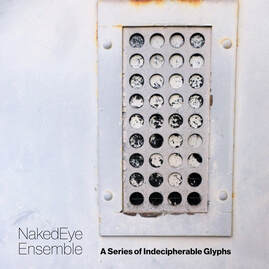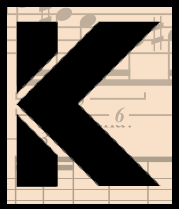 A Series of Indecipherable Glyphs (New Focus Recording) is an eclectic album by Pennsylvania-based group the Naked Eye Ensemble. If you’re not familiar with this ensemble I suggest giving them a listen. They’re a unique blend of modern classical, avant-garde, experimental rock-crossover and electro-acoustic band, all of which is featured on this stunning album. The album features original pieces by composers Nick Didkovsky, Whitney George, Rusty Banks, Molly Joyce, Aaron Jay Myers, Richard Belcastro, and an arrangement of Frank Zappa’s Sinister Footwear II. The album as a whole is a wonderful showcase of the composers - a number of whom wrote their pieces specifically for this group - but also demonstrates the versatility of the group and their ability to seamlessly weave in and out of any genre with ease. The album opens with Amelia’s Secret, a suite of 10 pieces by Nick Didkovsky. The material for each piece was derived through the composer’s custom software called Nerve2.hmsl, which uses algorithmic and stochastic processes to generate musical material. The end result is 10 highly unique postcard pieces that feature Didkovsky’s very idiosyncratic sound world that fuses heavy metal idioms with modernism and classical traditions. It covers the gamut from hypnotic swirling textures to dense interwoven counterpoint and walls of sound. Overall, Amelia’s Secret is an impressive collection of pieces that serve as a good introduction to Nick’s music, as well as a showcase of the versatility of the ensemble and a great opener for the album The second piece featured on the album is an arrangement of Frank Zappa’s Sinister Footwear II - the version found on Zappa’s 1984 album Them or Us. The ensemble executes Zappa’s intricate rhythmic complexity and overlapping melodic phrasing with seeming ease. The standout for me, as a huge Zappa disciple, is Chad Kinsey’s guitar solo. Zappa devotees will probably know that the guitar feature on this particular piece is a key feature with a long list of guitarists who have contributed to recordings. Kinsey’s solo is a mesmerizing onslaught acting as a centerpiece in the middle of the arrangement that transitions perfectly into the thematic material of the 2nd half. If you’re a Zappa fan then this is a must-listen, and if you’re not a Zappa fan then this might make you a convert. The next two pieces on the album share a connection in that they are centered around the concept of time while utilizing recordings of clocks and repetition of a steady pulse. Whitney George’s [These Hands] Hold Nothing, scored for guitar, bass, vibraphone, piano and electronics, opens with reocrdings of mechanical and clocklike sounds (the “hands”) that culminate in an explosive pulse. The piece quickly becomes a dichotomy of consistent quarter note pulse that gets passed around the ensemble while the other instruments decorate around it with tintinnabuli, lyrical melodies and interruptions. There are also brief moments of rhythmic dissonance in which some voices break from the strict duple divisions to create rhythmic and temporal dissonances within the framework. George’s piece is a wonderful example of really dedicating a work to a single concept and drawing as many possibilities out of a singular idea, especially one so simple and direct. It’s a piece that derives its beauty from the details of the whole and exploration of moments as they develop and change over time, even though the piece maintains a consistent identity throughout Following George’s captivating work is Rusty Banks Dum Spectas Fugio (while you watch, I flee; a common phrase often found on and associated with sundials and clocks. Banks’ piece also focuses on strict pulse with auditory references to machines and specifically to clocks, similar to George in that regard but different in that it takes on a more active, playful and rhythmically varied approach. It is scored for flute, clarinet, saxophone, cello, guitar, bass, percussion, piano/controller, but it could be said that this piece is scored for “prepared mixed ensemble” in which each member takes on a different type of cock sound through assigning pre-recorded clock sounds to accompany the more traditional timbres. The piece floats between different approaches to time - strict and constant, slow, fast, pulsed but sustained juxtaposed against pulsed and articulate. The central idea is that time can maintain a certain identity, but the rate at which we perceive it can change depending on context. I think that concept is executed quite well, and even if that central core were to get lost in the translation I would still find this a very engaging and rewarding listen The fifth work on the album continues the focus on repetition and minimalist approaches with Molly Joyce’s aptly titled Less Is More for piano and percussion. This one stands out being the only duo composition on the album (with the exception of selections from Didkovsky’s suite), so that alone sets it apart. The central focus of consistent pulse is established right out of the gate with the piano playing a single note in tandem with a kick drum. Over time new notes and melodic fragments are injected into the framework and doubled by the percussionist on glockenspiel. Similar to George’s work, this is also a wonderful example of dedicating oneself to a single idea and exploring it thoroughly. While that is a central tenet of minimalism, I don’t know that I would necessarily label this piece as simply minimalist because of the variation from moment to moment, even though the pulse and repetition is at the center of the structural framework. There is a noticeable change in tempo that occurs near the midpoint of the piece in which lower piano octaves are introduced, the energy intensifies and the melodic fragments that once interrupted sparingly become the central focus of the musical fabric The penultimate piece on the album is Aaron Jay Myers’ stunning Strabismus for flute, clarinet, saxophone, guitar, bass, drum set, piano; a rock and jazz inspired composition that evokes many of the same idioms one hears in the Zappa arrangement earlier in the album. Strabismus contains intricate rhythms, unison melodies, bombastic interruptions, frenetic energy and a harmonic palette that exists comfortably in both modernist styles and experimental rock or heavy metal. Myers takes full advantage of the unique instrumentation of the Naked Eye Ensemble and their ability to fluidly drift in and out of various styles and aesthetics with an organic flow from one section to another, creating an interesting and engrossing musical narrative. In contrast to the preceding works, Myers focuses on moment-to-moment instrument interactions, variations of the similar materials passed through different timbres, elongations and tructations of ideas, hocketed melodies, and rhythmic counterpoint. Overall I found this to be a wonderful piece that demands repeated listens to catch all of the rapid-fire musical detail and nuance. If you’ve ever wondered what a piece inspired by catnip might sound like, look no further than Richard Belcastro’s Nepetalactone, for the full ensembl. This piece is similar in style/aesthetic to Myers’ in that there is a much clearer influence of rock and jazz, as well as the use of heavily pulsed intricate rhythmic interplay within the entire ensemble, but both works maintain a clear sense of the composers’ unique identities. As I stated previously, the central concept of the piece is an exploration of the effects of catnip on cats. The piece shifts in and out of calm placid music juxtaposed against frantic, exciting and energetic sections with shifting pulsed infectious grooves. The formal structure offers a calm opening with a marked change in the second section introducing the first rock-inspired section that eventually fades into another period of calm reflection. The final section of the piece begins just after the midpoint of the recording and extends through the end and returns to the previous groove-oriented material from earlier. While still frenetic it eventually settles into a consistent 7|8 with combating saxophone and guitar solos. In the same way the Didkovsky was a great showcase of the ensemble’s breadth, Belcastro’s piece is a very fitting end for what is a really stellar and exciting album from start to finish I really cannot recommend this highly eclectic and beautifully recorded album enough. There is guaranteed to be something in there for everyone, and I feel would serve as a great primer for anyone who might want to dip their toe in the world of contemporary music. The Naked Eye Ensemble Is: Susanna Loewy (flutes), Christy Banks (clarinets), Ryan Kauffman (saxophones), Peter Kibbe (cello), Chad Kinsey (electric guitar), Mike Bitts (electric bass), Darren Lin (percussion) and Ju-Ping Song (piano/keyboards, founder). Released on New Focus Recordings Produced by Ju-Ping Song Recorded and Mixed by Chad Kinsey Mastered by Ryan Sterber, Oktaven
0 Comments
Leave a Reply. |
Reverberations is a catch-all page for everything that doesn't fit into a neat and tidy box of blog posts and interviews. Enjoy!
Full Directory of Reviews |

